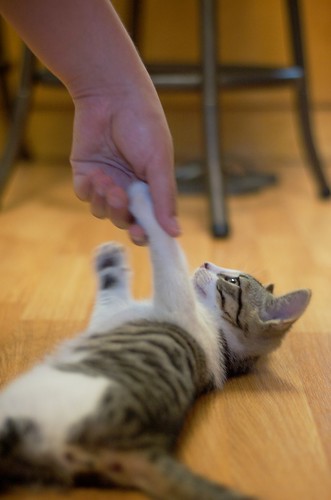
© 2010 Simon Hucko
My wife and I brought home a kitten last week from the shelter, and as you might expect I've been taking plenty of photos of the little guy. Sensationalist title aside, I figured I would take this chance to talk a bit about how to get the best photos of your pets. (Incidentally, these tips work pretty well with little kids too.)
- The first and most important thing is to get down to their level. Crawl on the floor if you have to. I'm assuming most of you are much taller than your pets. A photo from standing height is just not very interesting. Even if you zoom in on your pet, you're getting the same boring perspective that you see every day. Get your lens down to your pet's eye level, and suddenly you see the world as they see it. This is true for people as well, we connect much better to the subject if we're at eye level.
- If you want a static portrait of your pet, your best bet is to get them right before or right after they take a nap (especially if they're still young and rambunctious). They're much more likely to stay still during that quiet period between play and sleep, and if you time it right they'll still be alert enough to look at you and the camera. I got this photo of Radames right before he nodded off for a nap on the kitchen floor (and yes, I was lying on the ground):

© 2010 Simon Hucko
- If you're trying to get a more active shot, your best bet is to shoot a lot. You're going to miss a lot of shots due to focus, timing, or motion blur. Shoot plenty, and then you can pick the ones that worked later. Don't spend all your time staring at your LCD screen, either, or you'll miss moments. Once I get my exposure locked in, I stop checking the shots and just shoot. You can also work on pre-framing and pre-focusing your shots, waiting for the pet to come to you and grabbing the frame. That's what I wound up doing for this one:

- If you're taking photos indoors, I recommend using your fast prime. Wider apertures and higher ISOs let you get a shorter shutter speed, which can help capture your pet as they run around and play. However, the extra speed comes at the price of depth of field, and with moving subjects a shallow DOF leads to more missed shots. See my point above about shooting a lot.
- Check your backgrounds. There's a lot of clutter and distracting backgrounds in your house. Shoot toward a wall or other plain vertical surface and you won't have to worry about your dirty dishes showing up in the frame. The other option is to open that fast prime up and blur out the mess.
- Avoid your built in flash. Nuked out photos of your pet on a dark background aren't the most flattering in the world, and chances are they're not going to sit there and let you blast a flash into their sensitive eyes more than once or twice. Again, open your aperture and boost your ISO. Window light helps, too - try to grab shots while they're looking into the world "out there."
- Shoot low, close and wide. The bigger the pet, the wider you can go. These make great "action" shots, and tend to have a nice dynamic feel to them. I've talked about this a bit before.
Hope that helps. If you've got another tip for pet photography, please share in the comments!
~S
[title of blog] on flickr
![[title of blog]](https://blogger.googleusercontent.com/img/b/R29vZ2xl/AVvXsEhJ8bvx_9_zOAREbXcrJRML7aVvJMbb90IYYYuyti384jeZHYQ9t8MK6_Kpt_1P4-pZw-QfF9kh4Sqci0vbopzLme862PPhuyPJcc7pRLUW1K1aNzts5YzuXIhgonq66MpjJCqfiWtfwUw/s1600-r/waterfall.png)




Great tips, great shot, great kitty!
ReplyDeleteRiley pretty much never sits still unless he's half- or fully-asleep, so 98% of my pictures of him are blurry. I just tell people he was born that way. :P
Great post Simon. Great kitty too. I can't wait to meet him.
ReplyDelete